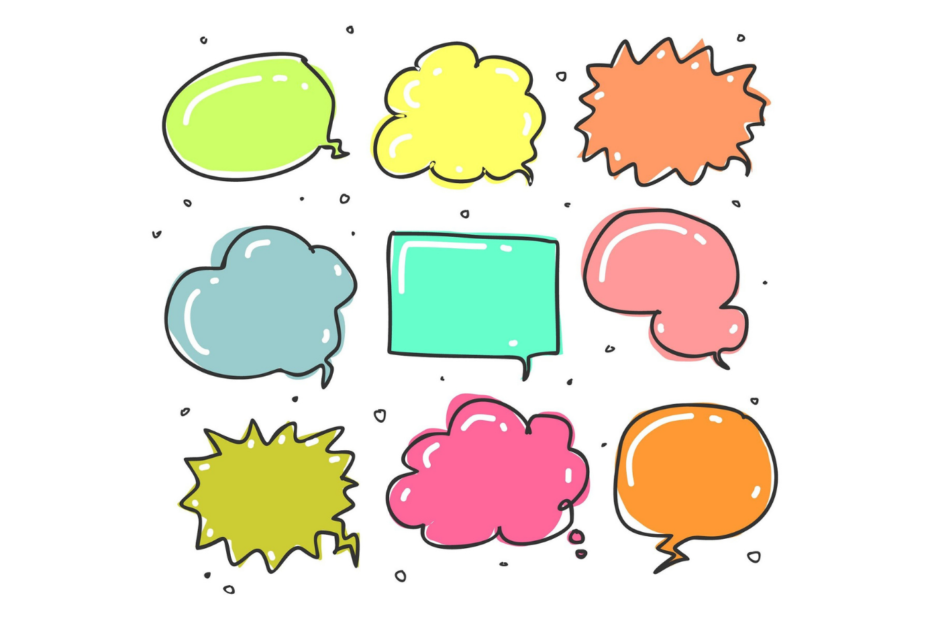When I was in fifth grade, my teacher had a poster on the wall titled “Better Words to Use Than ‘Said.’” It had myriad fun choices, like “exclaimed,” “demanded,” “growled,” “announced,” “scoffed,” and on and on and on.
Many of us learn from a young age that when we write, we should use exciting words that catch our reader’s eye. “Said” is a boring word that conveys no emotion or context; don’t we want our readers to know what the character is thinking or feeling or doing with their face?
Short answer: No, we don’t.
Slightly longer answer: Yes, of course we do, but there are better ways to do that than using exciting speech tags.
What are speech tags for, then?
The purpose of speech tags is just to tell the reader who is speaking at a given moment. They aren’t the point of dialogue, but are rather aides to give clarity to your characters’ words.
What your reader should be focused on when reading dialogue is the dialogue itself, not the speech tag. While writers often think that exciting speech tags add description to a scene, most of the time, all they do is distract readers from the dialogue.
How do I show emotion without emotional speech tags?
If your character is speaking in an angry or threatening way, “growled” might seem like a good speech tag. But consider the following examples:
“Take one more step, and you’ll regret it,” Tom growled.
“Take one more step, and you’ll regret it,” Tom said, menacing despite his seemingly relaxed demeanour.
“Take one more step, and you’ll regret it.” Tom’s hands rested calmly on the table and his voice was soft, but I could see in his cold eyes that he wouldn’t hesitate for a moment if I failed to listen.
In the first example, “growled” carries more weight than anything said between the quotation marks. The dialogue has become less important than the speech tag, which is not what we want when writing speech.
In the second example, using “said” means that the emotion comes entirely from the dialogue and surrounding description. Without “growled,” we have to pay attention to what Tom means by his threat, and we have room to add description and characterization without it distracting the reader from the dialogue.
In the third example, we do away with the speech tag entirely. It’s still clear who’s speaking because we’ve added a sentence showing what Tom is doing. We also get to add even more characterization by making this its own sentence, rather than an add-on to the speech tag like in the second example.
What does this tell us? In the first example, all we know is that Tom is angry. In the second, we know that he’s menacing and means what he’s saying, even though “said” doesn’t tell us much. But in the third example, with no speech tag at all, we learn the most about Tom—he’s authoritative, threatening, and scary, and we get a much clearer picture than if we just said “he growled.”
Which speech tags can I use when “said” isn’t enough?
Sometimes you do need another word. “Said” cannot replace “shouted” or “whispered,” for example. I tend to tell my clients to only stick to “said” unless the change in volume is important, in which case, “shouted” or “whispered” are fine.
“Asked” is usually necessary for questions, but, as with “said,” it’s a perfectly acceptable word that doesn’t need to be replaced with “interrogated,” “demanded,” “questioned,” or any other distracting stand-in.
And from time to time, you can throw in a more exciting speech tag. If used sparingly, a “murmured” now and then can work. “Replied” can be useful, and if necessary, the occasional “scoffed” or “snapped” or “spluttered.”
“Hissed”
“Hissed” is an overused and problematic speech tag. To explain why, I’ll quote the fabulous Benjamin Dreyer from his book Dreyer’s English.
If your seething, exasperated characters must hiss something—and, really, must they?—make sure they’re hissing something hissable.
“Take your hand off me, you brute!” she hissed.
—Charles Garvice, Better Than Life (1891)
Um, no, she didn’t. You try it.
“Chestnuts, chestnuts,” he hissed. “Teeth! teeth! my preciousss; but we has only six!”
—J.R.R. Tolkien, The Hobbit (1937)
Okay, now we’re cooking.
Some speech tags to throw away forever:
-
-
“That’s what you think,” he came back.
-
“How do you know?” she questioned.
-
“Stop that!” they broke out.
-
“I don’t want to,” I stated.
-
“You do it,” she directed at him.
-
One last note: Actions are not speech tags.
From time to time we see non-speech actions used as speech tags:
“You choose,” he shrugged.
“Let’s go dancing,” she smiled.
This is wrong. Shrugging is not speaking. Neither is smiling. These must be mentioned as separate actions to the dialogue:
“You choose,” he said with a shrug.
“Let’s go dancing.” She smiled.
Could your dialogue benefit from a speech-tag review?
When I do a line or copy edit, I keep a careful eye out for speech tags that are distracting, misplaced, or unneeded. Get in touch today, and we can work together to make your characters and their dialogue the best they can be.
Molly Rookwood is an editor, reader, tea drinker, and cat mum in Halifax, Nova Scotia. She loves Jane Austen and epic fantasy, and her bookshelves are forever overburdened. When she’s not playing D&D or taking turns about the room, she can be reached at [email protected] or by following @RookwoodEditing on Twitter.


Pingback: Rookwood Editing